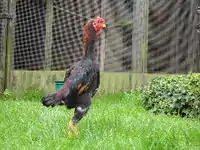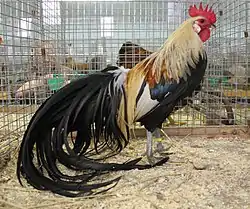List of Japanese chicken breeds
This is a list of the chicken breeds considered in Japan to be wholly or partly of Japanese origin. Some may have complex or obscure histories, so inclusion here does not necessarily imply that a breed is predominantly or exclusively Japanese.
| Local name | Other names | Notes | Image |
|---|---|---|---|
| Aizu-Jidori[1][2] | |||
| Chabo[1] | Japanese Bantam[2] |  | |
| Daigiri-Shamo[1] | single-combed Shamo | ||
| Echigo-Nankin-Shamo[1] | |||
| Ehime-Jidori[1] | |||
| Ekoku[2] | |||
| Gan-Dori[1] | Gankei[2] | ||
| Gifu-Jidori[1][2] | |||
| Hinai-Dori[1][2] | |||
| Hiroshima-Tsuuji[1] | |||
| Ingie[1] | Ingii-Dori[2] | ||
| Ise-Jidori[2] | |||
| Iwate-Jidori[1][2] | |||
| Izumo[1] | |||
| Jisuri[1] | |||
| Jitokko[1][2] | |||
| Kawachi-Yakko[1][2] | |||
| Kinpa[1] | Kinpachi-Dori[2] | ||
| Koeyoshi[1][2] | Long-crower | ||
| Ko-Shamo[1][2] |  | ||
| Kumamoto[1] | Kumamotoshu[2] | ||
| Kureko-Dori[1][2] | |||
| Kuro-Kashiwa[1][2] | |||
| Mie-Jidori[1] | |||
| Mikawa[1] | Mikawashu[2] | ||
| Minohiki[1] | Minohiki-Dori[2] | ||
| Miyaji-Dori[1][2] | |||
| Nagoya[1] | Nagoyashu[2] | ||
| Nankin-Shamo[1][2] | |||
| Ohiki[1] |  | ||
| Oh-Shamo[1][2] | |||
| Okinawa-Hige-Jidori[1][2] | |||
| Sado-Hige-Jidori[1][2] | |||
| Satsumadori[1][2] |  | ||
| Shibattori[1] | Shiba-Dori[2] | ||
| Shoukoku[1] | Oguni-Dori[2] |  | |
| Tokara-Jidori[1] | |||
| Tokuji-Jidori[1] | |||
| Tomaru[1][2] | Long-crower | ||
| Tosa-Kojidori[1] | |||
| Tosa-Kukin[1] | Tosa-Cochin[2] | ||
| Tosa-Onagadori[1] | Onagadori[2] |  | |
| Tosa-Jidori[2] | |||
| Totenko[1] | Totenko-Dori[2] |  | |
| Tsushima-Jidori[1][2] | |||
| Ukokkei[1][2] | |||
| Uzurao[1] | |||
| Utaicharn[1] | Utai-Chahn[2] | ||
| Uzurao[1] | |||
| Yakido[1] | Ygido, Hachikido[2] | ||
| Yamato-Shamo[1][2] | |||
References
- Masaoki Tsudzuki (2003). Japanese native chickens. In: Hsiu-Luan Chang, Yu-chia Huang (editors) (2003). The Relationship between Indigenous Animals and Humans in APEC Region. Taipei: Chinese Society of Animal Science. Pages 91-116.
- [Editorial Committee Office of the Japanese Country Report, Animal Genetic Resources Laboratory, National Institute of Agrobiological Sciences, Japan] ([n.d.]). Country Report (For FAO State of the World’s Animal Genetic Resources Process); annex to: Barbara Rischkowsky, D. Pilling (editors) (2007). The State of the World's Animal Genetic Resources for Food and Agriculture. Rome: Food and Agriculture Organization of the United Nations. ISBN 9789251057629. Accessed August 2017.
This article is issued from Wikipedia. The text is licensed under Creative Commons - Attribution - Sharealike. Additional terms may apply for the media files.